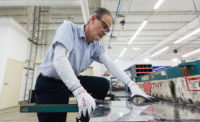Grandchildren change one’s view on everything. My grandson, Kellan, is 4. In 2100, he will be 88 years old and one of an estimated 11 billion people in the world. That’s almost 5 billion more people than today.
To accommodate this growth, the global community must truly embrace sustainable development, which is widely defined as development that meets the needs of the present without compromising future generations’ ability to meet their own needs. Many organizations have embraced sustainability, viewing it as a way to become more competitive, ensure long-term viability and meet stakeholder demands. Many also publish annual sustainability reports to publicly demonstrate their commitment to balancing social, economic and environmental actions in a responsible manner.
What’s often missing from these reports, however, is a proper accounting of worker safety and health. Protecting workers and physical assets, and ensuring business continuity, are vital elements if companies are to be truly sustainable. When we consider how many of the 11 billion people will be part of the global workforce in 2100, these issues take on even greater importance.
So how do we get more companies to include the protection of their human capital in their sustainability efforts? ASSE began to address this issue in 2009, when it formed a task force to examine how companies address OSH in their sustainability initiatives. This group’s conversations with key stakeholders revealed that most firms claiming to be sustainable were understating the importance of OSH. Based on its findings, the task force recommended that ASSE become a stronger advocate for OSH as a key component of sustainability.
In forming its recommendations, the task force focused on the International Labor Organization’s estimates that 2.1 million workers die globally each year from work-related injuries and disease. As the global population grows, those numbers will climb too, unless OSH professionals advocate for all workers to receive at least basic workplace protections. We must encourage businesses to build adequate safety systems into their supply chains by educating them about the multiple benefits this produces, including enhanced brand image, reduced liability, decreased costs and continuity of product supply.
Being a global voice for the value of workplace safety is a vast undertaking. That’s why the Society partnered with AIHA, Institution of Occupational Safety and Health (U.K.) and Canadian Society of Safety Engineering to form the Center for Safety and Health Sustainability (CSHS) in 2011.
CSHS represents nearly 100,000 global safety professionals. Its vision is “for all organizations to consider the safety, health and well-being of workers, customers and the community as part of their sustainable business practice.” To date, CSHS has worked with corporations, investors and sustainability rating organizations to propose global OSH metrics that help measure an organization’s progress toward achieving a sustainable workplace free of fatal and debilitating injuries and illnesses.
CSHS has also published research that examines multiple aspects of safety and sustainability. One report, “Current Practices in Occupational Health and Safety Sustainability,” examines the OSH reporting practices of the 100 most sustainable companies in 2011 as identified by the rating organization Corporate Knights. CSHS found that five of the companies ranked had more than 10 fatalities, including one with 49 worker fatalities the previous year. These alarming findings highlight why workplace safety must be a prime measure in any system that recognizes sustainable organizations. To its credit, Corporate Knights has since modified its ranking criteria to include workplace fatalities as a key measure of sustainability. Such is the goal of CSHS—to be a voice for safety in sustainability in order to effect change.
CSHS has also published a “Best Practice Guide for Occupational Health and Safety in Sustainability Reports.” OSH professionals can use this guide to help their organizations report on key safety and health metrics, and provide the kind of nonfinancial information that investors now seek as part of their decision-making process.
As OSH professionals, we must promote the value of occupational safety and health in the global workplace for current workers, as well as for future workers like my grandson Kellan. If we don’t, who will?




